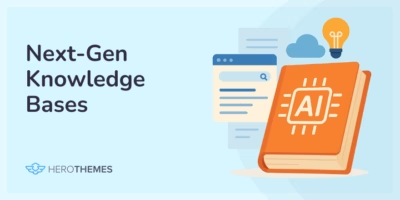AI in Customer Service: The Ultimate Guide for Support Teams (2025)
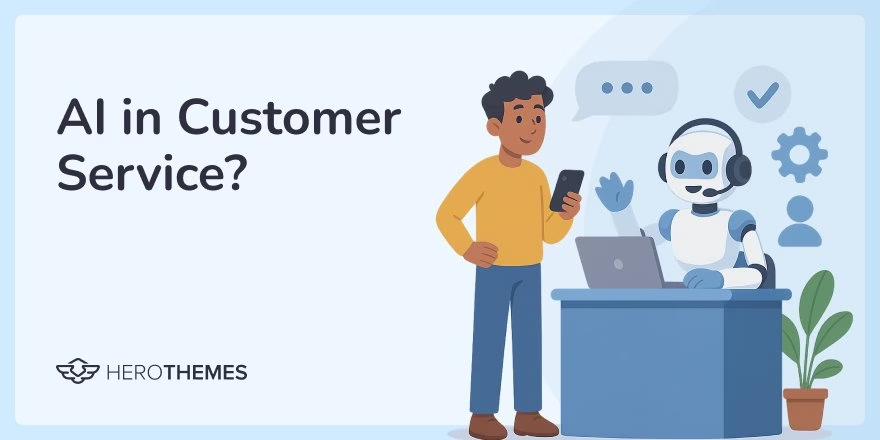
Imagine a customer asking a question at 2 AM and receiving a helpful answer in seconds, without anyone on your team waking up.
Sounds futuristic, doesn’t it?
In fact, this is happening today thanks to artificial intelligence (AI) in customer service.
Now before you roll your eyes at another “AI changes everything” claim, let me be clear. AI isn’t magic. It’s a tool. A powerful one. And if you use it right, it can save time, reduce costs, and improve customer satisfaction without turning your service into a robot parade.
I’m here to explore how AI is changing customer service and to teach you how to incorporate it into your support workflows without compromising quality. Let’s begin!
TL; DR: Key Takeaways
- AI is helping businesses scale and personalize their customer service.
- AI is not here to replace agents; but to automate repetitive tasks and assist agents to provide better service.
- With the right tools, such as the Heroic Knowledge Base and Heroic Inbox, implementing AI in customer service can be simple.
- AI usage in customer service will grow exponentially, and customers will expect the same speed and quality from others that don’t adapt AI.
In This Guide
What is AI in Customer Service?
AI in customer service refers to the use of intelligent computer systems to perform or assist with support tasks that typically require human effort.
That could be:
- A chatbot answering FAQs.
- An assistant that drafts email replies to save your agents’ time
- A bot that tags and prioritizes tickets.
- A voice bot helping customers reset a password on a call.
Unlike old-school scripted bots, modern AI understands natural language. Ask “How can I change plans?” or “Can I upgrade?” and the AI gets both, even if phrased differently.
Why Does AI in Customer Service Matter?
Let me tell you what support managers care about. Fewer tickets, faster replies, happier customers, and lower cost. AI helps with all four.
- Speed and 24/7 Availability: AI doesn’t need sleep or coffee breaks. It can provide instant answers at any hour. Customers appreciate quick responses. In fact, 51% of consumers prefer interacting with a bot for immediate assistance. By handling FAQs and simple requests instantly, AI cuts wait times dramatically, leading to happier customers.
- Consistency and Accuracy: Human agents might give slightly different answers or occasionally make mistakes, especially when tired or handling multiple tickets. AI, when trained on a verified knowledge base, gives consistent, accurate answers every time. I’m not talking about firing your team, I’m talking about automating simple tasks with AI, so your agents can focus on more critical tasks.
- Lower Cost: Scaling a support team is expensive, especially as you grow. AI scales without you adding more seats.
- Helping Support Agents, Not Replacing Them: AI shines in doing grunt work. Sorting incoming tickets, drafting initial responses, retrieving account details, so that your human support staff can focus on what they do best: solving complex problems and building relationships.
- Personalization: AI can pull in context from a user’s profile, past orders, and preferences to tailor the answer. So the reply doesn’t feel generic, it feels like someone knows them.
For example: “Hi Sarah, since you upgraded last week, you now have access to premium reports. Here’s how to find them.” Which is much better than saved replies or templates. - Insights and Proactive Support: Beyond direct interactions, AI can crunch large volumes of support data to spot trends. It might identify that a particular product issue is spiking in tickets this week, alerting your team to post an advisory or fix a bug. AI-driven sentiment analysis can gauge customer emotions from their words, flagging unhappy customers for follow-up. Knowing these insights in real time helps businesses be proactive rather than just reactive.
AI in Customer Service 2025: Key Use Cases and Examples
AI isn’t a single tool – it’s a broad set of technologies with many applications.
Let’s break down some specific use cases of AI in customer service, with real-world examples and practical tips.
1. AI-Powered Chatbots for Instant Support
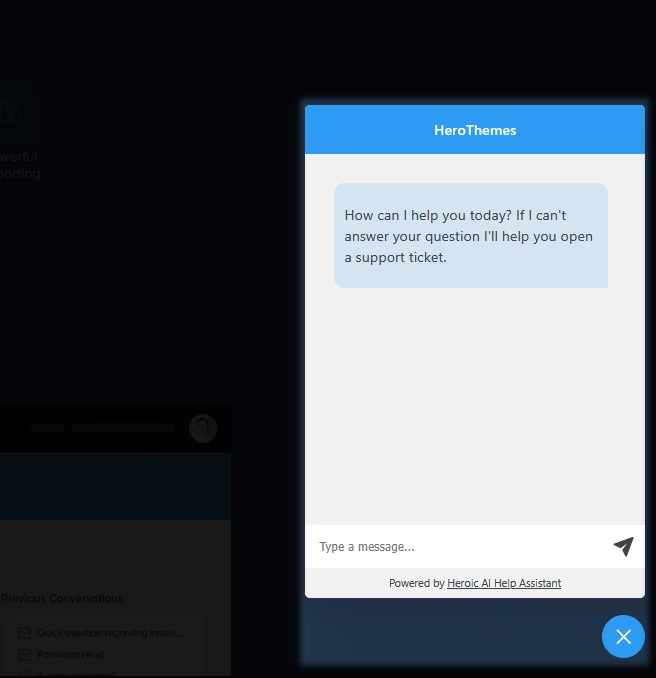
When you visit a website and a chat box pops up asking “How can I help you?”, that’s often an AI-powered chatbot.
IBM, for instance, leverages Watson AI in its customer support to help businesses find answers faster.
Here at HeroThemes, we use an AI chatbot to answer common questions about our products. You can access the chatbot by clicking the Help icon in the bottom right corner of your screen.
Chatbots are one of the most visible AI tools in customer service today. They can handle common questions, guide users through basic tasks, and even help with sales, all through a friendly chat interface.
Tips and Facts to Implement AI Chatbot Properly:
- Use chatbot tools that provide options to train AI based on your knowledge base. This allows more accurate and consistent answers.
- Best for frequently asked questions (FAQs), simple tasks (like checking an account balance or order status), and initial triage.
- Great for global businesses with customers in different time zones.
- If a chatbot is poorly implemented (for example, it can’t understand the question or gives irrelevant answers), it can frustrate customers.
- Allow an easy way to talk to a human when needed. A smart strategy is to have the bot politely acknowledge when it’s out of its depth – e.g., “I’m sorry, I can’t find that info. Let me connect you with a support agent for further help.” This way, the customer doesn’t feel stuck.
I highly recommend you to try Heroic Knowledge Base to create an AI chatbot based on your knowledge base, which is very easy to set up.
2. AI for Email and Support Ticket Automation
Not all customers use chat, many still send emails or fill out support tickets. AI can dramatically improve how these inquiries are managed and answered.
If your support team currently lives in an inbox or a ticketing system, this use case is for you.
Use Case:
Think of the repetitive email questions your team answers every day: “How do I reset my password?”, “Can I upgrade my plan?”, “Do you offer refunds for X?” Rather than typing out each response (or even copying from templates) manually, AI can handle much of this process.
For example, an AI system can scan an incoming email, recognize it’s a password-reset question, and automatically reply with the step-by-step instructions. AI can generate accurate responses based on past interactions and knowledge base articles, giving customers quick answers without waiting on a human agent.
Bank of America’s AI assistant, Erica, doesn’t just live in chat, it also helps with processing requests that might have traditionally been emails or calls. As of 2025, Erica has handled over 2 billion customer interactions and can resolve 98% of queries. That’s millions of inquiries that never had to be manually typed out by a human, saving huge time and effort.
Tips and Facts for Using AI for Email and Support Ticket Automation:
- Answer customers faster, often instantly with an auto-reply that actually addresses the question.
- Ensure nothing falls through the cracks.
- Reduce agent’s workload.
- Auto-sort and prioritize tickets based on their context.
- Best for common questions via email, support ticket classification, and drafting replies.
- Great for enforcing consistency in tone and information.
3. AI-Powered Knowledge Bases and Self-Service
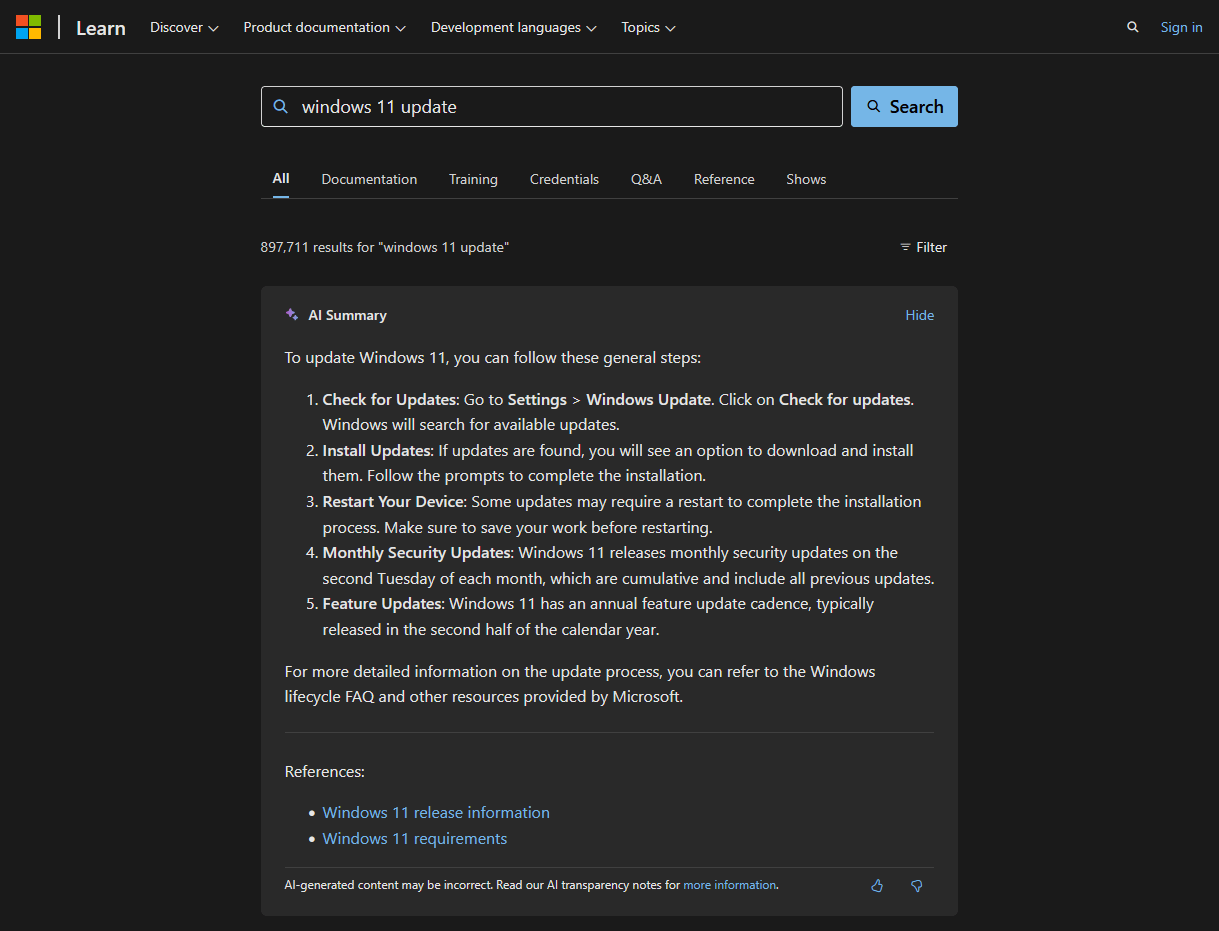
A knowledge base (KB) is like a library of help articles, FAQs, how-to guides, and documentation that customers can search through to find answers on their own. A big part of customer support initiatives.
AI can supercharge self-service by making knowledge bases more interactive and intelligent.
For example:
Traditionally, a customer might type a question into a help center search bar and scroll through articles. Now, with AI, the knowledge base can turn into a conversation.
Imagine a customer on your site asks the assistant, “How do I create an account?” The AI instantly scans your Knowledge Base and responds with the relevant steps from your “Account Creation” article, perhaps even linking that article.
If the customer then asks a follow-up question like, “What if I forget my password?”, it can similarly fetch that answer. It’s like having a librarian who instantly finds the exact book page you need. Except the librarian is a bot and the book is your support docs.
Tips and Facts for Using AI-Powered Knowledge Bases:
- Customers actually enjoy finding answers on their own. It’s faster and they feel accomplished.
- Customers get instant, specific answers instead of wading through manuals.
- It boosts self-service success rates, more people solve issues without opening tickets, which reduces workload.
- AI turns a static FAQ page into a dynamic Q&A experience.
Heroic Knowledge Base software can be a great starting point into AI knowledge base and self-service experience.
Explore:
How To Create a WordPress Knowledge Base — Step-By-Step Guide
How to Create an Internal Knowledge Base
How To Create an IT Knowledge Base
10+ Best Customer Self-Service Solutions of 2025
4. AI Voice Assistants and IVR Systems
AI isn’t limited to text-based chat and email, it’s also transforming phone support, enhancing overall customer service experience.
Voice AI assistants use technologies like speech recognition and natural language understanding to talk to customers. These systems are far more advanced than the old touchstone menus.
If you’ve ever called a customer service line and been greeted by a friendly automated voice that can actually understand what you’re saying (“Please tell me what you need help with in a few words…”), you’ve encountered AI in voice form.
Benefits:
- Fast, hands-free support.
- It’s convenient for customers who may not be tech-savvy with apps or just prefer calling.
- For businesses, it means many routine calls (like balance inquiries, order status, store hours, simple troubleshooting) never need an agent.
- Reduces call center hold times for everyone, since only the more complex calls go to humans.
- Voice bots can also work alongside humans. For example, transcribing and analyzing calls in real time to give agents suggestions (a form of agent-assist via voice).
While the benefits are undoubtedly good, designing a good voice AI is challenging.
It must handle different accents, background noise, and the infinite ways people can phrase things.
With AI Voice Assistants it’s best to start small (like “track my package” or “pay my bill”) and expand as the system learns, and if the AI doesn’t understand after a try or two, it should automatically pass the caller to a human agent to avoid frustration.
5. Sentiment Analysis and Customer Insights

Sometimes it’s not about directly answering the customer, but understanding them.
Sentiment analysis is an AI technique that evaluates whether a piece of text (or speech) is positive, negative, or neutral in tone.
In customer service, sentiment analysis can be a powerful tool to gauge customer satisfaction and spot issues early.
Use Case
Suppose you manage a support team that handles hundreds of live chat or email conversations a day. It’s hard to read every single exchange, but an AI could analyze them and flag ones where the customer seems frustrated (e.g., lots of negative words or an angry tone).
For example, an email saying “I’ve been waiting two weeks, this is unacceptable” would come through with a “negative” sentiment score and could alert a manager to intervene or at least ensure the issue gets priority.
Benefits:
- Gives you insights into customer satisfaction.
- AI can route messages based on sentiment.

Explore: Top 8 Alert Email Subject Lines
6. Personalized Recommendations and Predictive Support
A more advanced (but increasingly common) use of AI in customer service is using data to anticipate needs and personalize interactions. This blurs into marketing and sales a bit, but it’s very relevant to service too, especially in B2C retail and B2B account management.
Use Case:
A company providing, say, cloud software could use AI to predict which clients might need support before they even ask. For example, if usage data shows a client hasn’t set up a key feature, the AI might prompt a support outreach: “Hey, need any help onboarding feature X? Many clients find it useful.” This proactive support can increase product adoption and satisfaction.
HubSpot uses AI in its support to analyze which knowledge base articles a customer has viewed, so when the customer does reach an agent, the agent knows what the customer tried already and doesn’t repeat information. A simple personalization that saves time.
Benefits:
- Build a more tailored experience.
- Boosts customer satisfaction and loyalty.
- Can drive revenue indirectly (happier customers stick around and buy more).
Next, let’s look at the tools and steps to actually implement these AI solutions in your own support operations.
Tools and Platforms for AI-Powered Customer Service
Implementing AI in customer service isn’t magic, you’ll need the right tools.
Fortunately, there’s a range of solutions from simple plugins for your website to enterprise-grade software.
The best choice depends on your business size, tech stack, and specific needs.
1. Heroic Inbox: Your Shared Inbox with AI Potential
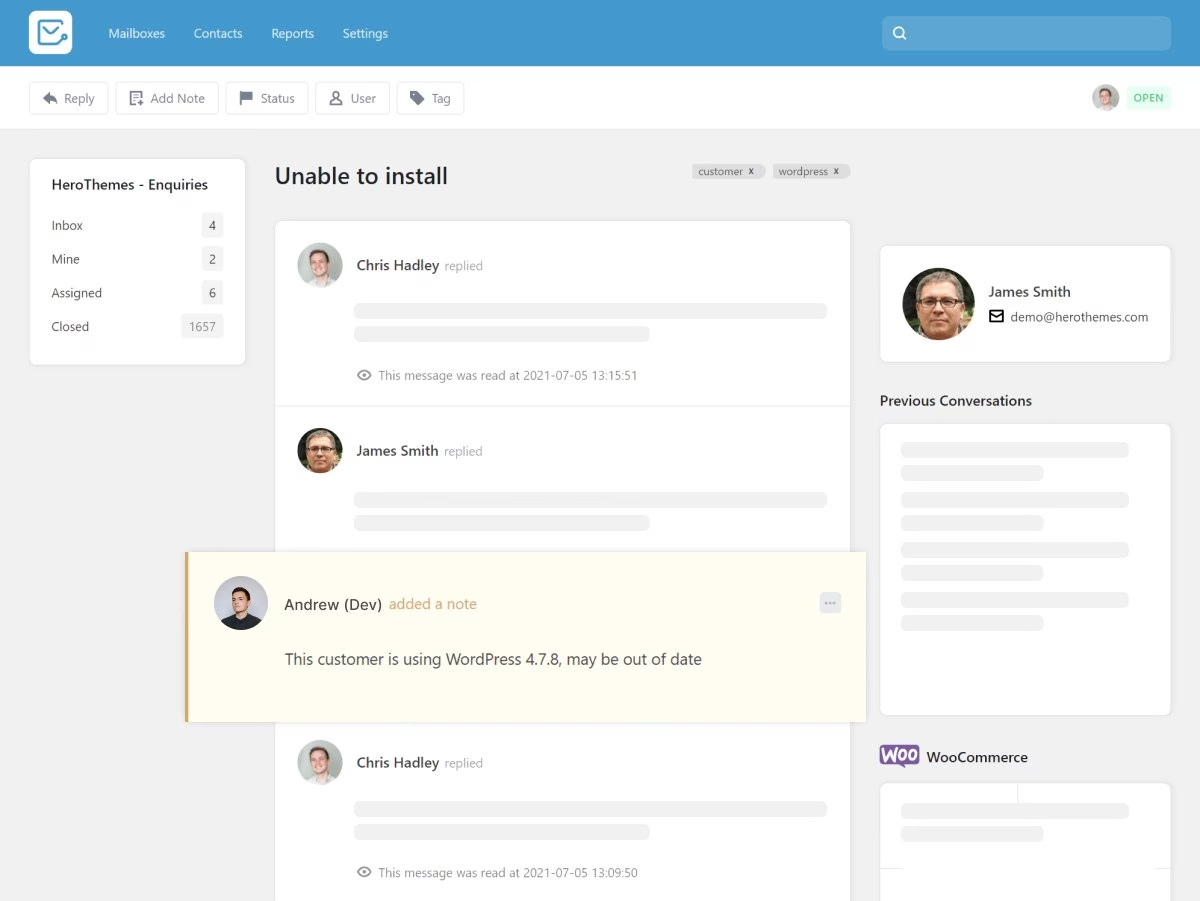
Heroic Inbox is a WordPress help desk plugin that turns your WordPress dashboard into a shared email inbox for support.
If you’re a small business or startup that handles support via a generic email (like support@yourdomain.com), Heroic Inbox lets you pull those emails directly into a dashboard where your whole team can collaborate. Think of it as having a lightweight, self-hosted Zendesk or Help Scout, right inside WordPress.
AI Integration:
While Heroic Inbox itself is a platform, you can integrate AI in various ways.
For example, you might use a WordPress automation plugin to connect Heroic Inbox to an AI service.
One approach some businesses take is using Zapier or Uncanny Automator with the OpenAI API. e.g., when a new ticket comes in, send the text to OpenAI to generate a draft response, then add that draft as a private note for the agent to review. The agent can then edit and send it.
This kind of integration effectively gives you an AI co-pilot for email support.
Another potential is using AI to analyze the inbox and give managers a daily summary: “You got 50 emails today. 10 were about login issues (all handled by the bot), 5 were escalation-worthy,” etc.
2. Heroic Knowledge Base: Self-Service with an AI Boost
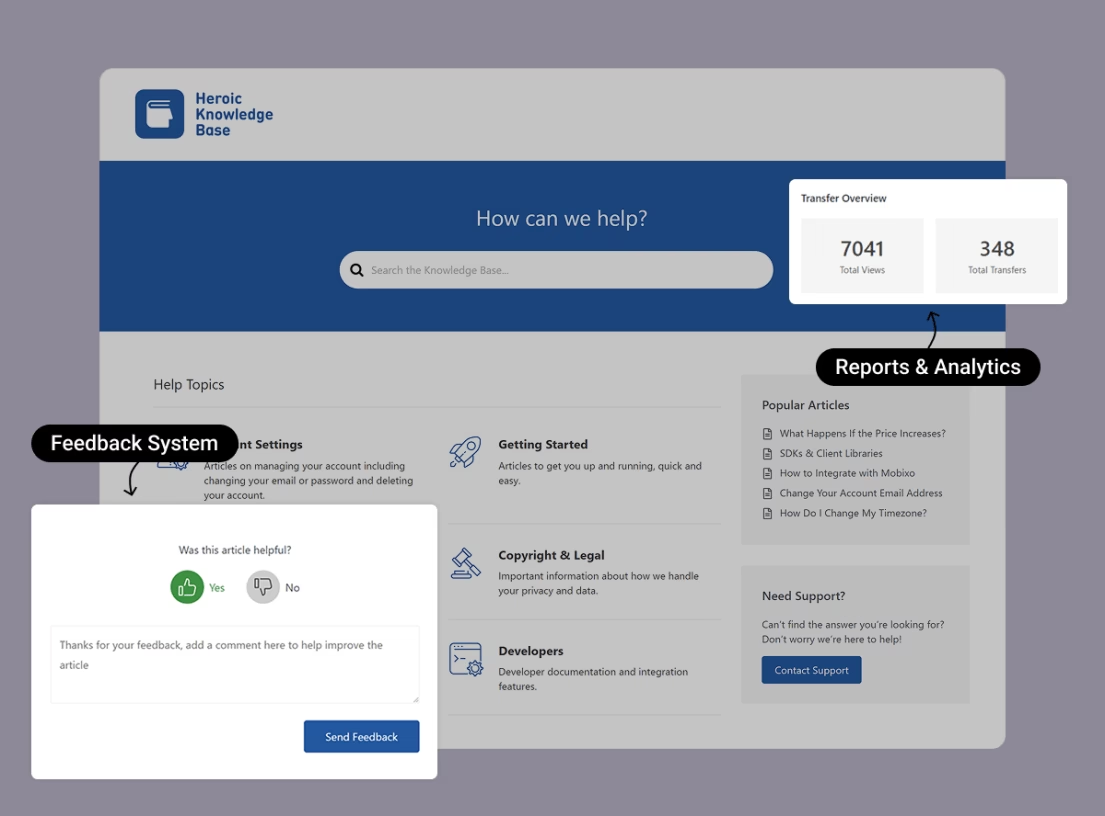
Heroic Knowledge Base (Heroic KB) is another WordPress plugin by the HeroThemes team. It enables you to create a professional, searchable knowledge base or documentation site with ease.
If you’ve ever envied those “Help” sections on big company websites, Heroic KB lets you have that on your own site: Categories, articles, search bar, feedback buttons, reports, AI integrations and all.
AI Help Assistant:
The star feature of this topic.
Heroic KB offers a built-in way to add an AI chatbot trained on your knowledge base.
It leverages OpenAI’s ChatGPT models to understand questions and Pinecone (a vector database) to retrieve the most relevant chunks of your articles to form an answer.
Plus, as its WordPress based system, you can easily integrate it with hundreds of other plugins and automation platforms.
Other AI Capable Tools for Customer Service
While Heroic Inbox and KB are excellent for WordPress-based businesses and small businesses wanting more control and integration, it’s worth noting some broader-market tools:
- Help Scout, Zendesk, Freshdesk: These are popular customer support platforms (SaaS) that now incorporate AI features.
- Intercom: Known for live chat, Intercom has “Fin”, an AI bot that can handle customer queries by pulling answers from your website or knowledge base. It’s quite similar in spirit to Heroic KB’s assistant, but as a hosted service.
- IBM Watson Assistant / Google Dialogflow: These are more enterprise-level AI frameworks for building chatbots (including voice bots). A larger company might use these to create a very custom AI agent that’s deeply integrated with their back end systems. They require more development work but can be powerful.
The good news is you don’t need a PhD or a six-figure budget to start using AI in customer service.
Many of the tools above like Heroic Inbox and Knowledge Base are designed for non-developers.
Explore:
How to Integrate ChatGPT with Your Knowledge Base
12 AI Virtual Assistants for Small Businesses (2025 Guide)
How to Implement AI in Your Customer Service: Step-By-Step
Feeling convinced about AI’s benefits but not sure how to actually get started?
Implementing AI in customer support can be done in gradual, manageable steps. You don’t have to (and shouldn’t) automate everything overnight.
Below is a step-by-step game plan to introduce AI into your support workflow smoothly:
Step 1. Define Your Goals and Use Cases
Start by identifying what you want to achieve with AI.
- Are you trying to reduce response times?
- Handle more tickets with the same team size?
- Offer 24/7 support without hiring a night shift?
Clarify the primary pain points in your support operations.
For example, you might decide: “We want to deflect simple billing and password-reset questions away from our live agents” or “We need after-hours coverage for urgent issues.” Having clear goals will guide which AI solution to pursue first (chatbot vs. email automation vs. knowledge base, etc.).
Step 2. Inventory Your Common Inquiries and Tasks
Next, list out the most common customer questions or tasks your support team handles. This could come from FAQs, top search terms on your help center, or just asking your agents.
This step is crucial as AI learns from data, so you need to know what patterns or Q&As to train it on.
Maybe you find, for example, that 30% of your tickets each week are “How do I update my address?” and “Can I change my plan?” Those are prime candidates for AI to handle.
Likewise, note repetitive tasks like categorizing tickets, merging duplicate requests, or checking order statuses. This list will highlight where AI can have quick wins.
Step 3. Get Your Knowledge Base and Data Ready
AI is only as good as the information you feed it.
Before deploying a fancy bot, ensure your knowledge base or FAQ content is up-to-date and comprehensive.

If you don’t have a knowledge base, consider creating one. Even a simple FAQ page helps.
For example, if you plan to use a chatbot, it will either use your knowledge base articles for info (as Heroic KB’s assistant does) or you’ll script it with Q&A pairs.
In both cases, you need solid, accurate answers ready.
Similarly, if you’re doing email automation, prepare some saved reply templates that the AI can draw from.
Essentially, tidy up your support content. It’s a bit like prepping the textbooks before expecting the “student” (AI) to answer questions from them.
Step 4. Choose the Right Tool or Platform
With your use case and content in mind, select an appropriate AI tool.
If your goal is instant website support, an AI chatbot like Heroic Knowledge Base’s assistant makes sense.
If you want to automate email responses in WordPress, Heroic Inbox plus an AI integration could be the way.
For voice, you might look at a service like Twilio Autopilot or Dialogflow.
When choosing, consider factors like:
- Integration with current system
- Setup complexity
- The cost
Many starts with something like a chatbot that doesn’t require coding. You can often configure it via a visual interface.
Step 5. Implement on a Small Scale (Pilot Test)
Resist the urge to roll it out everywhere on day one.
Pick a small scope for your first AI implementation and treat it as a pilot.
For example, enable the chatbot only on your support homepage for a set of FAQs, or use AI to handle just one category of emails (like password resets).
This controlled launch allows you to gather data and feedback without risking major disruptions.
During this phase, monitor how the AI performs: Are customers satisfied with the answers? Is it giving correct information? Are there questions it couldn’t handle?
Step 6. Train the AI and Provide Oversight
“Set it and forget it” does not apply here.
AI needs training and tuning. Use the pilot phase results to improve.
If the AI got some answers wrong or if it didn’t recognize certain phrasing, you’ll need to update its training data or rules.
For instance, you might add more variations of a question to the chatbot’s training set, or feed additional articles into the knowledge base.
It’s also wise to have human oversight: perhaps assign a support agent to review a sample of AI-handled chats or emails each day initially.
Step 7. Educate and Involve Your Support Team

Bring your support team into the process early. Change can be intimidating; some agents might worry AI will replace them or drastically change their job.
Explain that the AI is a tool to assist them, not replace them. Show them how it works and even involve them in training it.
For example:
- Agents could help write the knowledge base articles or saved replies that the AI will use.
- When AI suggestions come in (like draft responses), encourage agents to review carefully and not just hit send.
- A final scan with an AI detector could then be used to ensure the content is original and not unintentionally flagged as machine-generated
By involving the team, you also tap their frontline wisdom to make the AI better. After all, your agents know the nuances of customer questions; their input can refine the AI to handle those nuances.
Step 8. Communicate to Your Customers (When Appropriate)
Be transparent with customers where it makes sense.
If you introduce a chatbot, label it clearly as an AI assistant (e.g., “Chat with our Virtual Assistant”). People tend to be patient with a bot that occasionally doesn’t get it, as long as they know it’s a bot.
If you hide that fact, frustration can spike when the “agent” gives a weird answer. Also, assure customers that human help is behind the scenes.
For example, you might announce: “We’re testing a new AI assistant to help answer your questions faster. Don’t worry, our human team is still here and ready to help if needed!”
This type of messaging builds trust and sets proper expectations.
Step 9. Monitor Metrics and Gather Feedback
Track how your AI implementation is performing against your goals.
Key metrics could be:
- Reduction in average response time
- Number of tickets deflected (self-service success rate)
- Customer satisfaction scores for AI-handled interactions vs human-handled
- Agent productivity stats (like tickets per agent per day).
Also, directly seek feedback. You can add a quick survey after a chatbot session (“Did you get what you needed?”) to gauge the satisfaction.
Step 10. Iterate and Expand
Based on the data and feedback, make improvements.
Maybe you find the AI chatbot does great with product questions but poorly with account-specific issues, so you refine it to hand off account questions sooner.
Perhaps the email AI is solid for English but struggles with Spanish inquiries, so you add more multilingual training data or adjust your workflow for non-English emails.
Once the pilot is running well, consider expanding AI to other areas: more topics, more channels.
By following these steps, you can implement AI as a thoughtful enhancement to your support, rather than a disruptive overhaul.
Impact of AI on Support Agents and Customer Experience
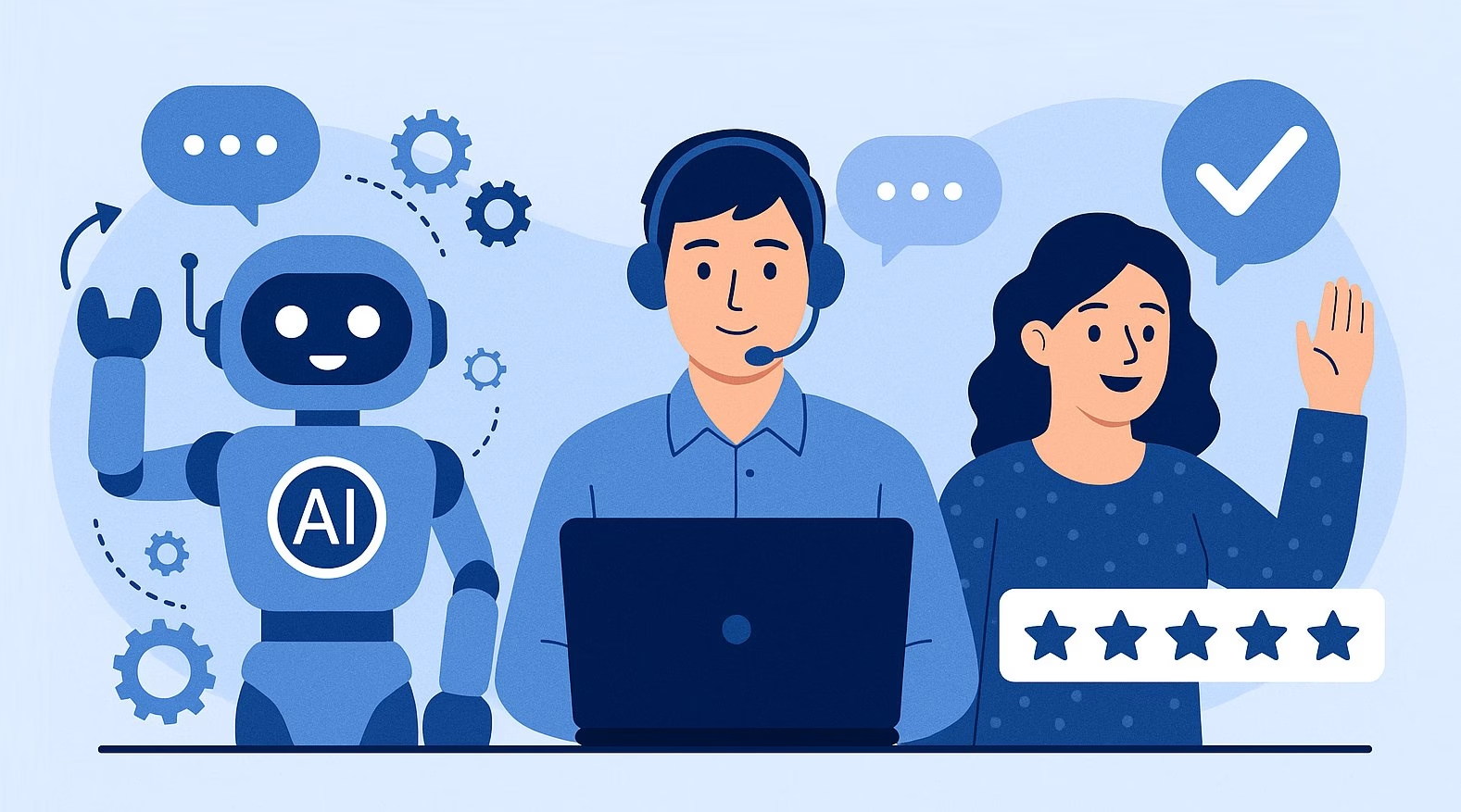
Whenever AI in support is discussed, two big questions arise: “What does this mean for support agents?” and “How will customers feel about it?” Let’s address both frankly.
Impact on Support Agents
- Changing Role (for the Better): Support agents will see their roles evolve from pure “answer factory” to more of a guide and problem-solver.
- Productivity Boost and Skill Development: With AI handling a chunk of repetitive tasks, agents can handle more tickets at the same time, or spend more time on each customer who truly needs it. This can reduce burnout since agents aren’t as overworked on volume, and they can focus on quality.
- Job Security Concerns: It’s important to acknowledge that agents might worry about AI “taking my job.” The reality observed in many companies is that AI takes tasks, not jobs; at least when implemented thoughtfully.
- Morale and Motivation: Agents might initially feel demoralized if a bot can do part of their job. But over time, many come to appreciate that they’re no longer chained to repetitive queries.
Impact on Customer Experience
- Faster Answers, Higher Satisfaction: Customers today value speed and convenience highly. AI in customer service directly caters to that: instant answers at any hour.
- The Human Backup: However, there is a flip side. If AI fails to understand or solve the issue, customers can get frustrated. We’ve all been in that loop of yelling “Representative! Representative!” at an automated phone system that isn’t getting it. That’s why the best customer experiences with AI happen when AI is seamlessly integrated with human support.
- Personalization and Warmth: Surprisingly to some, AI can actually make service feel more personal in certain ways. By pulling data about the customer, an AI can greet them by name, reference their recent order, and even adjust tone if it detects the customer’s mood.
- Trust and Comfort: There’s still a segment of customers who are wary of AI. It’s important to maintain trust by being transparent and ensuring data security.
- Consistent Service Across Channels: One great thing customer experience with AI is more consistency.
- Ethical and Fair Treatment: AI can help here by removing some human biases in support. For example, AI doesn’t get impatient or judge a customer for asking a “dumb” question. It responds the same polite way each time.
The Future of AI in Customer Service
Looking ahead, how might AI further transform customer service in the next few years?
The landscape is rapidly evolving, who could have imagined the leap from clunky phone trees to conversational AI in just a decade!
Here are some trends and possibilities on the horizon:
- Even Smarter Chatbots (Generative AI everywhere)
- Unified AI across Channels: We’ll likely see AI that follows the customer across channels.
- Proactive and Predictive Support: Instead of waiting for customers to contact support, AI will help companies anticipate issues.
- AI Agents Handling Complex Tasks: Right now, AI typically handles simple, repetitive tasks and leaves complex issues to humans. But the bar for “complex” keeps rising. AI is gradually taking on more complex tasks as its reasoning ability improves.
- Emotional AI and Empathy: This is a bit experimental, but there’s work on AI detecting not just sentiment (positive/negative) but deeper emotions or stress levels from voice and text.
- Greater Agent-AI Collaboration: We mentioned “agent assist” tools; expect those to become standard issue in call centers. Every support agent might have an AI helper widget on their screen that listens to the conversation and provides real-time suggestions, much like a skilled coach.
- Customer Expectations and Norms: As AI becomes ubiquitous, customers will likely raise their expectations for service quality even higher.
Overall, the future of AI in customer service looks bright and dynamic. It’s a future where AI will be involved in virtually every customer interaction in some form. Whether visible to the customer or behind the scenes aiding a human rep.
Final Thoughts
AI customer service is no longer just a buzzword, it’s a practical tool that businesses of all sizes can leverage today.
We covered a lot in this guide, so you can start building a modern customer service operation that is fast, efficient, and scalable – yet still personable and customer-centric.
AI is a powerful ally for support teams when used thoughtfully.
But remember, at the heart of customer service is solving problems and caring for customers. AI should not change that – it should enhance your ability to do it effectively.
Further Reading
14 Best Practices to Improve Customer Service and Support
9 Best Customer Service Software for Any Business
Customer Service in Dropshipping: Best Practices, Tips, and Tools
The 6 Best Subject Lines for Support Email Requests
15 Empathetic Customer Service Subject Lines
Top 10 Companies Using AI for Customer Service (Success Stories)

